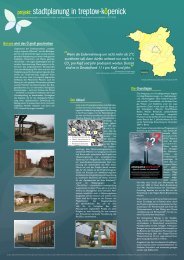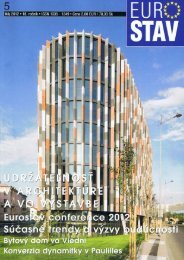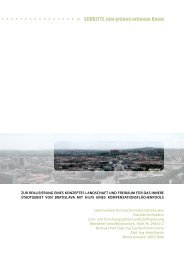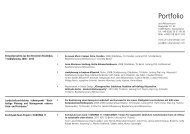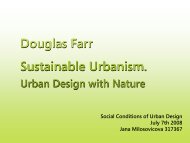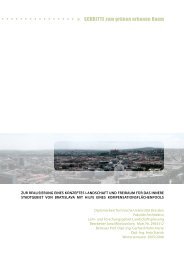Thesis document - Jana Milosovicova - Urban Design English
Thesis document - Jana Milosovicova - Urban Design English
Thesis document - Jana Milosovicova - Urban Design English
- No tags were found...
You also want an ePaper? Increase the reach of your titles
YUMPU automatically turns print PDFs into web optimized ePapers that Google loves.
Fig. 14 Photograph of the square and adjacentpark in Třeboň, Czech Republic, takenwith a thermal camera. The differences in temperaturesbetween the vegetation, façades androofs of the houses is visible. (Kravčík et al.2007, p. 33)Fig. 15 Aerial view of an industrial site in Berlin(Google)Fig. 16 Bioclimatic categorization of the samearea as a “burden” area (Environmental AtlasBerlin)As such, low albedo implies higher surface temperatures since largeramounts of energy are not reflected, but absorbed. This applies in caseof dark non-vegetated surfaces, in case of vegetated areas however,the cooling process of evapotranspiration takes place (Sass, online;Kravčík et al. 2007, p. 25). Vegetation has a darker colour and thus alower albedo than many other surfaces, e.g. white painted walls. Plantshowever, independently of reflectance, cool through evapotranspiration(fig. 14). This cooling effect of vegetation, evident from the infraredphotographs of the square and park in Třeboň (CZ), is much higher incomparison with the effect of reflectance. The temperature of the roofsand façades exceeds 30°C, whereas the temperature of the trees in thepark is around 17°C (Kravčík et al. 2007, p. 27-28). We can thus concludethat evapotranspiration is more effective than albedo.A hypothesis resulting from previous findings is, that even if albedoraising helps lower the air temperatures and the PET 14 by reflectingsolar radiation back into the atmosphere, this happens solely on local,microclimate level in the proximate distance to the particular surface;and it has no influence on the extent of the UHI and on the total heatamount in the atmosphere. This is because by reflecting, no transformationof incident solar radiation into the latent heat (the form of heatwith evaporative cooling effects) takes place. This can be confirmed inthe graphics, figure 15 showing a high-reflective surface of an industrialarea in Berlin; figure 16 showing the temperature “burden” impact ofthe same site. Thus, raising the surface reflectance should not be seenas “the only really effective way (…) to affect the radiation energy balance”as pointed out in Sass (online) and suggested by other authors(Gartland 2008). To truly affect the temperatures, building greeningmeasures should be preferred.The effectivity of the albedo parameter in densely built-up urban areasis arguable also due to another aspect: In an urban area, a great partof the reflected rays hits walls of adjacent buildings, and thus only asmall part of the solar radiation impinging on walls and streets is reflectedupward to the sky; most of the radiation being absorbed in thewalls of the buildings, regardless of the colour, to be stored as heat andreleased back into the atmosphere later (Givoni 1998, p. 269).For the above reasons, greening should have a higher priority indesigning of surfaces rather than creating light and reflectivesurfaces. Raising albedo values of non-vegetated surfaces should beseen as a surface adjustment measure of secondary importance, andshould be applied where no greening measures are possible (as e.g. incase of road infrastructure). Nonetheless, surface albedo is one offactors influencing local surface temperatures and should notbe omitted when deciding about the character of constructionmaterials, even when these are to be covered with vegetation. Dark,non-vegetated (low albedo) surfaces should be replaced bylight and reflective (high albedo) surfaces so that less sunlightis absorbed. For the purpose of glare avoidance, other light coloursmay be used instead of white.14 Physiological Equivalent Temperature, see glossary18Climate Sensitive <strong>Urban</strong> <strong>Design</strong> in Moderate Climate Zone: Responding to Future Heat Waves. Case Study Berlin Heidestrasse/Europacity



